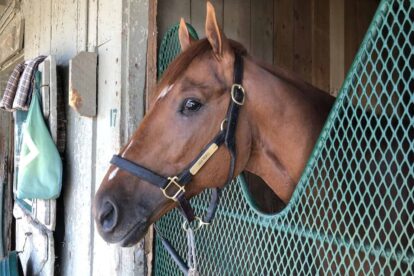It’s easy to pick up a pitchfork or flaming torch and join the masses that are marching down Union Avenue towards Saratoga Race Course, chanting that they want a bigger field in this Saturday’s $600,000 Grade 2 Jim Dandy Stakes.
The masses have every right to be livid: lately, one of the cornerstones of the Saratoga meet and the main local prep for the Grade 1 Travers Stakes has been decimated. From 2014 to 2017, the Jim Dandy was run with fields of five, six, four, and six. This year, five horse have been entered in the Jim Dandy: Vino Rosso, Tenfold, Flameaway, Sporting Chance and Reride. Over the ten years prior, the average field size was seven.
The crowds want big fields that bring opportunities to score on the biggest days, so putting a small race in the middle of a late stakes-laden sequence does not enthrall those looking to find value or hit a longshot. Named after the 3-year-old colt Jim Dandy, winner of the 1930 Travers at 100/1 odds while beating the Triple Crown winner Gallant Fox, most people think the race should live up to its name and provide a few chances to hit a big price.
It seems logical to ask for some type of change. It’s more difficult to make the counter-argument and support keeping things the way they’ve been, though.
Many point at the $100,000 Curlin Stakes, run the day before the Jim Dandy, for poaching possible entries from the Jim Dandy, which has been run since 1964. Both races are restricted to 3-year-olds and both events are run at 1 1/8 miles in distance.
To compound the issue, the Grade 1, $1,000,000 Haskell Invitational is run at Monmouth Park on Sunday. Another 1 1/8-mile event, the Haskell offers the winner a free ride to the Breeders’ Cup Classic. The pilfering of 3-year-olds is even further exacerbated by the Grade 3 West Virginia Derby at Mountaineer Park, which will be held next Saturday, August 4, again at the same 1 1/8-mile distance.
So, with all these routing races for 3-year-olds within an eight-day window, the finger can’t be pointed squarely at the Curlin as the main offender.
In fact, there is something unique about the Curlin that makes all the difference and should be fully understood before Saratogians light up their torches in protest. The Curlin is restricted to 3-year-olds that have not won a graded sweepstakes over 1 mile, opening it up to still-developing horses that have not reached the graded stakes winner’s circle while routing in their careers.
Without understanding this important restriction, it’s easy for onlookers to say, “Hey, if this horse is running in the Curlin a day before the Jim Dandy at the same distance, then they should just run in the Jim Dandy.”
That is not true in most instances, though, and the Curlin provides a stepping-stone for horses that have developed later than others in their crop and may be trying stakes company for the first time.
Such was the case in 2016 when a late-developing horse named Connect made his way through the maiden and allowance ranks that spring before winning the Curlin impressively for the Chad Brown barn. This set Connect up for a run in the Travers, where he was a disappointing sixth behind one of the greatest performances in the race’s history when Arrogate set the track record. Connect returned off of that educational trip to take the Grade 2 Pennsylvania Derby over the eventual 2017 Horse of the Year Gun Runner. Connect finished the year by winning the Grade 1 Cigar Mile. If the Curlin didn’t exist and Connect was forced to run in the Jim Dandy off of an allowance win, would his career have been as successful?

That’s obviously a question that we can’t answer, but it needs to be noted that the Curlin is useful for a horse’s development. It did the trick back in 2014, too, when a lightly-raced horse named V. E. Day won the Curlin in his fifth career start at 8-1 odds. The Jimmy Jerkens trainee parlayed that win into a Travers triumph at 20-1.
Going back to 2009, the first time that this race was named and run as the Curlin, a horse named Blame won in his fifth career start. Blame would go on to win the Grade 1 Clark Handicap that year before famously beating the great Zenyatta by a head in the 2010 Breeders’ Cup Classic to end his career.
Now, am I licking my chops to bet a five-horse Jim Dandy field? There’s always ways to make money betting around short fields in multi-race wagers, so there will still be opportunities to score, but the Dandy is certainly less appetizing in its current state. Is there something that can be done? Would a purse increase help draw more entries? Is a Jim Dandy / Travers double bonus an incentive NYRA could implement to entice owners and draw more entries? I’m not sure what the answer is, but all I’m saying is that the Curlin isn’t to blame (pun intended). The Curlin is serving its purpose and shouldn’t receive the heat this week that it’s sure to garner.
This year, the Curlin will get even more attention because the Grade 1 Florida Derby runner-up and Belmont Stakes third-place finisher Hofburg has been entered by his Hall-of-Fame trainer Bill Mott.
Based on his resume, Hofburg will likely be the 1-5 odds-on favorite in the five-horse field (after the scratch of Reride to run in the Jim Dandy, as reported by DRF’s Dave Grening), adding fuel to the torches hoping to burn away the race. The other four expected runners include one from trainer Steve Asmussen (Zing Zang), two from trainer Linda Rice (American Lincoln and Nicodemus), and Madison’s Luna for trainer Phil Bauer.
Aside from a stepping stone, this would also be class relief for Hofburg. Per a NYRA press release Mott said of the Curlin, “We want to have a look at it. It doesn’t always have to be easier. Sometimes, they can get a really nice horse in the Curlin. We want to have the option. Our focus is on the Travers at 10 furlongs.”
So, are the days of big Jim Dandy fields done? Would eliminating the Curlin be the answer? If so, then what race would allow late-developing 3-year-olds a place to grow? The debate will roar on annually and provide plenty of fodder for fans as we kick off the second half of the three-year-old season.

The Turn; Coaching Club Deja Vu
The great Yankees catcher Yogi Berra once said, “It’s like deja vu, all over again.”
It’s that strange feeling like you’ve been in the exact same situation before.
While preparing for the Grade 1 Coaching Club American (CCA) Oaks last Sunday, I felt like I was living the same events that occurred two years ago.
The first race that I ever covered for RacingDudes.com was the 2016 CCA Oaks. Earlier that week, the undefeated juvenile filly champion Songbird arrived in Saratoga to much fanfare and an anticipated showdown with a worthy foe, Carina Mia.
The crowd was ready to see Songbird, the #1 filly in the country, and she didn’t disappoint. Songbird went right to the lead early and Carina Mia tested her in the far turn, but Songbird dismissed that rival in the stretch, pulling away to win by 5 1/4 lengths.
Fast forward to 2018 and the same scenario played out. The Kentucky Oaks winner Monomoy Girl arrived with less fanfare, as she wasn’t crowned a juvenile champ and isn’t undefeated. Her worthy adversary? The multiple Grade 1 winner Midnight Bisou.
The same exact results occurred. Monomoy Girl went right to the lead early before Midnight Bisou stalked her at the top of the stretch. Like a flashback in time, the top filly coming into the race dismissed her top rival in the stretch, and Monomoy Girl pulled away to win by 3 1/2 lengths.
It’s way too early to compare Monomoy Girl to Songbird and unfair to enter this discussion until Monomoy Girl’s racing career is complete, but the eerie feeling in the air, the anticipation of a showdown, and the way that the CCA Oaks played out similarly only two years apart are the first of many comparisons that will surely be made between them.
Here are a few photos, starting with Songbird in 2016 and looking at Monomoy Girl in 2018:




Going to the Whip: Baby Watch
*Catherinethegreat lived up to her name in a romping win in the Grade 3 Schuylerville Stakes for trainer Mark Casse on opening day.
*A few weeks back, Asmussen told me, “We feel very strongly about our 2-year-olds right now.” No kidding! He had two very impressive maiden-breakers between his juvenile filly Lyrical Lady on Friday and a colt named Nitrous, who crushed a maiden field going 5 1/2 furlongs on Saturday. It would not be surprising to see them show up in the Grade 1 Spinaway Stakes and the Grade 1 Hopeful Stakes, respectively, to end the meet.
*In a thrilling edition of the Grade 3 Sanford Stakes on Saturday, Sombeyay gave trainer Todd Pletcher his seventh win in that event after chasing down a tough Strike Silver, who notably beat the aforementioned Nitrous in their debut race.

The Finish Line: Generation Now
This summer, I plan to continue providing great coverage of the Saratoga meet, but I’m approaching it a bit differently with a series called “Generation Now” where I highlight some of the game’s up-and-coming trainers that are making their mark on the game.
I’ve done a lot of reflective evaluation of the game recently and I think that there are too many people saying that big barns and “super trainers” are ruining horse racing. There are pros and cons to big barns, and I’ll discuss some of these points in my series, but people are missing the important point that big barns cultivate a new generation of trainers that are now going out on their own and will grow the game moving forward. These young trainers are giving owners more options for their top horses and may bring back the competitive balance that so many bettors and fans long for.
I’ll have plenty of time to cover all of this in my “Generation Now” series. Let me know if you have anybody or anything you want to see covered.
The first part of the series came out at the beginning of July when I interviewed trainer Jonathan Thomas before his pupil Catholic Boy won the Grade 1 Belmont Derby. Keep your eyes open for my next installment early next week when I release a full profile of trainer Chad Summers and how Mind Your Biscuits is preparing for the Grade 1 Whitney Stakes. We’ll also dive into how Summers is learning to build his barn with quality over quantity, something he learned the hard way last year.
Follow me @SaratogaSlim for all of your Saratoga news, views, and updates!











